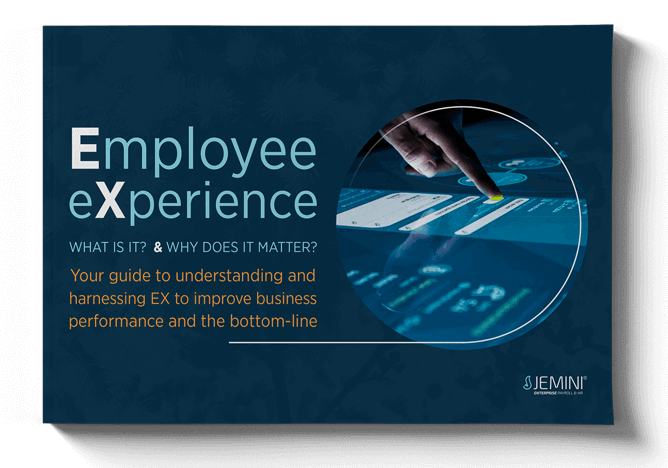Show me a business with skilled and engaged people that’s failing. Yes, ok, there are some which are simply overwhelmed by market forces beyond their control, but they’re few and far between.
Yet, by comparison, there are lots of great businesses with little or no people focus that fail. As a result of employee disengagement, they suffer from low productivity (including more mistakes and wasted time), the negativity and stress generated by high staff turnover (not to mention the 6-9 months of an employee’s salary that it costs to replace a departing staff member), high rates of sick leave and absenteeism, and a breakdown in communication and collaboration.

All of which translates to a measurable impact on your bottom line, sales, and customer service.
Despite this, many of these ‘at-risk’ businesses continue to place more reliance on their ERP and other business systems than their people-focused systems. Now I’m not saying that these functional systems aren’t essential for a business, but they don’t put people first. Instead of offering trust and empowerment, they concentrate on providing processes which in effect are controlling how people work, not developing them.
Think I’m overstating the case? Check out these stats.
Fact. It’s not all about money.
You’d think that after spending over $100 billion annually in an attempt to improve employee engagement in the workplace, there’d be something to show for it. But no, despite all the effort that kind of money buys, employee engagement numbers remain under 35%. And that’s a recent (2018) high. On average, 30% of employees have been engaged at work during the past 18 years.
Fact. But it also is (about money).
Harvard Business Review says that disengaged employees cost companies between $450 billion to $550 billion every year. Ouch.
And what’s worse, many employers overlook the direct link between higher costs caused by waste and low levels of employee engagement. Low employee engagement can lead to a higher turnover rate, which in turn drives up the cost of hiring and onboarding new people.
Fact. Happier people = higher profits.
Would you say that achieving a 21% increase in profits is something to sneeze at? Well, study after study shows a direct and positive correlation between employee engagement and increased company profits.
If all the negative news about how poor engagement is damaging your profits isn’t enough, then this stat alone should make you sit up and take notice – and do something.
Fact. It won’t happen overnight.
A recent study says that only 25% of employers have an established engagement strategy in place.
And engagement doesn’t just ‘happen’. So 75% of businesses still have to commit to a wide-reaching strategy that defines company goals and develops tactics to foster employee engagement, as well as establish metrics to benchmark their success.

Fact. Most employees feel discouraged.
The opportunity for career advancement is one of the main reasons people leave their job. Gallup's State of the American Workforce shows that only 30% of employees feel that their employers are concerned about their development within the company.
And we all know that unhappy employees (especially Millennials and Gen Zs), whether they leave or spread discontent, directly impact business growth.
Fact. Love and listening go a long way.
Recognition for hard work and achievement in both our business and private lives is important to us as human beings. No-one thrives by being ignored – and in the workplace this approach makes disengagement skyrocket.
So why do only 11% of employees say they only receive recognition weekly? And 30% receive recognition monthly.
And as a double whammy, 21% of employees say their employer never or rarely asks for their opinion or feedback. While it may not sound like a biggie, 13% of workers are ready to look for a new job because their employers don't collect feedback.
Fact. It’s the destination, and the journey
While it might be obvious that employees need to understand what their job entails, and what’s expected of them, as well as the company's goals and missions, it seems it’s not.
Gallup says only 60% of employees claim to know what’s expected of them at work. So that’s 40% of employees unsure of the destination, and unclear on how to get there. (Get, where?) Which makes you wonder if the ‘obvious’ is so evident that it’s overlooked. Some studies suggest that if you improve this statistic by just 20%, you can up retention rates by 14% and production by 7%.
Fact. I hate my boss.
Sorry about the finger-pointing, but a recent study says that employee disengagement starts with their manager, not the company itself. In fact, 75% of workers state that they left a job because of their supervisor or manager. (One hell of a reminder that engagement strategies need to be from the top down!).
Fact. Good intentions are no longer enough.
Some of these facts are pretty sobering. The bottom line is that if you want to improve employee engagement rates, as well as retention and productivity rates, you must have an employee engagement program. And, of course, the tools and resources to make sure that engagement is ongoing and successful.
Jemini Employee Experience mockups
Explore more...
Share this page
Ready to transform your HR & Payroll process?




